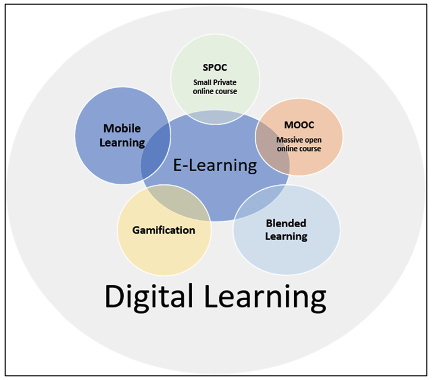Exploring Managerial Barriers and Strategic Opportunities for E-Learning Deployment in Afghanistan
DOI:
https://doi.org/10.38043/jimb.v9i1.5535Keywords:
Barriers of e-learning, E-learning, Opportunities of e-learning, Distance learning AfghanistanAbstract
E-learning has common meanings with the terms network-based education, distance learning, web-based education, and computer-based education. Today, e-learning is a common learning tool for education due to its effectiveness. Due to the Covid-19 lockdown, governments shifted their regular education to an e-learning system. Apart from opportunities, this shift created challenges and obstacles to its implementation. We aim to investigate the barriers and opportunities of e-learning deployment in public universities. Hence, a case study research was designed, and data was gathered through questionnaires and interviews with 96 individuals from Kunduz, Parwan, Kabul, Takhar, Ghor, and Samangan universities, encompassing diverse fields of study. The data were analysed using SPSS 26. According to this research, 63% of participants strongly agreed with the effectiveness of e-learning implementation. Furthermore, certain opportunities and obstacles emerged after the utilization of e-learning platforms by both students and lecturers. The challenges of e-learning deployment were lack of access to the internet, lack of stable electricity, and poverty. Contribution to the literature: In comparison with the existing literature, the current study provided an analysis of e-learning in its tension-filled relationship with the broader institutional structures and sociocultural realities of public universities in Afghanistan that circumscribe teaching and learning. The analysis provided entrées into infrastructural conditions, economic contexts, and socio-political circumstances that facilitate and inhibit the implementation of e-learning while offering suggestions for policymakers and practitioners in similar consideration of areas that are similarly unstable.
Downloads
References
Al-Azawei, A., Parslow, P., & Lundqvist, K. (2016). Barriers and opportunities of e-learning implementation in Iraq: A case of public universities. International Review of Research in Open and Distance Learning, 17(5), 126146. https://doi.org/10.19173/irrodl.v17i5.2501
Alanazi, A. S., Almulla, A. A., Ahmad, M., & Khasawneh, S. (2023). EXPLORING THE E-LEARNING SUPPORTING SYSTEMS FOR STUDENTS WITH SPECIAL NEEDS 1 INTRODUCTION Recently, policies governing education have experienced notable modifications in relation to the models of support implemented. According to the conventional fram. RGSA Revista de Gesto Social e Ambiental, 112. https://doi.org/https://doi.org/10.24857/rgsa.v17n7-023
Alruwais, N., Wills, G., & Wald, M. (2018). Advantages and Challenges of Using e-Assessment. International Journal of Information and Education Technology, 8(1), 3437. https://doi.org/10.18178/ijiet.2018.8.1.1008
Barikzai, S., Bharathi S, V., & Perdana, A. (2024). Challenges and strategies in e-learning adoption in emerging economies: a scoping review. Cogent Education, 11(1), 2400415. https://doi.org/10.1080/2331186X.2024.2400415
Dubey, P., Pradhan, R. L., & Sahu, K. K. (2023). Underlying factors of student engagement to E-learning. Journal of Research in Innovative Teaching and Learning, 16(1), 1736. https://doi.org/10.1108/JRIT-09-2022-0058
Frugh, Q. A. (2019). E-learning Problems Finding of Afghanistan Universities. 9(2), 16. https://doi.org/10.9790/1959-0902040718
Hakimi, M., Fazil, A. W., Ahmady, E., Qarizada, A., & Quraishi, T. (2024). Cyber Opportunities: Fostering Womens Empowerment through E-Commerce in Afghanistan. Room of Civil Society Development, 3(1), 112. https://doi.org/10.59110/rcsd.275
Hakimi, M., Shahidzay, A. K., & Aslamzai, S. (2024). Exploring Factors Influencing MOOC Adoption in Afghanistan's Educational Landscape. International Journal of Scientific Multidisciplinary Research, 2(1), 97-112.https://doi.org/10.55927/ijsmr.v2i1.8020
Kapenieks, A., & Zuga, B. (n.d.). INTERNET , TELEVISION AND MOBILE TECHNOLOGIES FOR INNOVATIVE ELEARNING Interneta , telev zijas un mobile tehnolo iju izmantoana inovar v m e-studij m. 301308.
Lockee, B. B., & Gros, B. (2020). Learning, Design, and Technology. Learning, Design, and Technology, 123. https://doi.org/10.1007/978-3-319-17727-4
Musawi, S. Z., & Baktash, J. A. (2021). Identification and Ranking of Cloud-Based Applications in E-Learning of Afghanistan: A Case of Public Universities. Elsya: Journal of English Language Studies, 3(2), 7885. https://doi.org/10.31849/elsya.v3i2.5796
Monib, W. K. (2023). Afghan undergraduate students perceptions toward e-learning. E-Learning and Digital Media, 20427530231180029. https://doi.org/10.1177/20427530231180029
Nasrat, N., Khamosh, A., & Lavangnananda, K. (2020). Challenges and Hurdles to E-learning Implementation during COVID-19 Outbreak: A Case of Shaikh Zayed University. Proceedings - 2nd International Conference on Informatics, Multimedia, Cyber, and Information System, ICIMCIS 2020, 242246. https://doi.org/10.1109/ICIMCIS51567.2020.9354313
Nouraey, P., & Al-Badi, A. (2023). Challenges and Problems of e-Learning: A Conceptual Framework. Electronic Journal of E-Learning, 21(3), 188199. https://doi.org/10.34190/ejel.21.3.2677
Oryakhail, M. S., Saay, S., & Nasery, H. (2021). Challenges in the implementation of E-Learning in Afghanistan Higher Education. 2021 International Conference Advancement in Data Science, E-Learning and Information Systems, ICADEIS 2021, 16. https://doi.org/10.1109/ICADEIS52521.2021.9702070
Quraishi, T., Bayani, B. M., Yashar, S., Daudzai, M., & Salamzada, R. (2024). Integration of Mobile Learning Technologies in Afghanistan Universities: Opportunities and Challenges. 2(1). https://doi.org/10.59535/es.v2i1.227
Salam, M. (2019). Fundamental Issues and Challenges Facing Women in Distance Education. FLEPS 2019 - IEEE International Conference on Flexible and Printable Sensors and Systems, Proceedings, 6(1), 146. https://doi.org/10.1016/j.surfcoat.2019.125084
Salehi, S. J., & Hosseini LARGANI, S. M. (2020). E-Learning challenges in Iran s higher education system and its implications in the realm of good governance. Smart Cities and Regional Development Journal, 4(1), 921.
Salih, S. K., & Taniwall, N. J. (2020). Issues and Challenges of E-Learning System Adoption in a Public University of Afghanistan: A Case Study of Shaikh Zayed. IOSR Journal Of Humanities And Social Science (IOSR-JHSS), 25(1), 6369. https://doi.org/10.9790/0837-2501046369
Sarwari, K., Kakar, A. F., Golzar, J., & Miri, M. A. (2022). Distance learning during COVID-19 in Afghanistan: Challenges and opportunities. E-Learning and Digital Media, 19(2), 144162. https://doi.org/10.1177/20427530211044757
Snmez, S., & Korucuk, M. (2023). The Effect of E-Learning Styles on Online Learning. Shanlax International Journal of Education, 11(S1-July), 216226. https://doi.org/10.34293/education.v11is1-july.6203
Zandi, S., Abedi, D., Yousefy, A., Changiz, T., Yamani, N., & Kabiri, P. (2003). Electronic Learning as a New Education Technology and its Integration in Medical Curricula. Http://Journals.Mui.Ac.Ir, 11, 6172.
Rahimi, N., Rashidi, A., Hakimi, M., & Shirpoor, M. (2024). Navigating E-Governance and ICT Dynamics in Afghanistan Higher Education. International Journal of Scientific Multidisciplinary Research, 2(2), 137-152. https://doi.org/10.55927/ijsmr.v3i2.8011

Downloads
Published
How to Cite
Issue
Section
License
Copyright (c) 2024 Musawer Hakimi, Sayed Zabihullah Musawi, Khudai Qul Khaliqya

This work is licensed under a Creative Commons Attribution-ShareAlike 4.0 International License.
